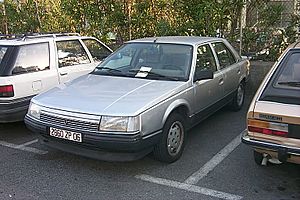Renault 25 facts for kids
The Renault 25 was a special car made by the French company Renault. It was a big, comfortable car, sometimes called an "executive car," which means it was designed to be fancy and smooth for longer trips. The Renault 25 first came out in 1983, taking the place of the older Renault 20 and Renault 30 models. It was built for almost ten years before being replaced by the Renault Safrane in 1992.
Quick facts for kids Renault 25 |
|
|---|---|
| Overview | |
| Manufacturer | Renault |
| Production | 1983–1992 |
| Assembly | France: Sandouville |
| Body and chassis | |
| Class | Executive car (E) |
| Body style | 5-door liftback |
| Layout | FF layout |
| Powertrain | |
| Engine | Gasoline and diesel from 2.0 to 2.9 L |
| Chronology | |
| Predecessor | Renault 20/30 |
| Successor | Renault Safrane |
Contents
What Made the Renault 25 Special?
The Renault 25 was known for its sleek, modern look and its comfortable inside. It was a "5-door liftback," which means it looked a bit like a sedan (a car with a separate trunk) but had a large back door that lifted up, like a hatchback, making it easy to load things. The engine was in the front, and it powered the front wheels, which is a common way cars are built.
Engines: The Car's Heart
The engine is what makes a car move. The Renault 25 had many different engine choices, giving drivers options for how much power they wanted. These engines used either gasoline or diesel fuel.
- Gasoline Engines: These engines ranged in size from 2.0 liters to 2.9 liters. The bigger the number, the more powerful the engine usually is. Some of the more powerful versions included:
* 2.0 i 12V: This was a 2.0-liter engine with 12 valves, making it quite efficient and powerful for its size. * 2.5 V6 Turbo: This was a very powerful engine. "V6" means it had six cylinders arranged in a "V" shape, and "Turbo" means it had a special device called a turbocharger that pushed more air into the engine for extra power. * 2.9 V6: Another powerful V6 engine, offering a smooth and strong ride.
- Diesel Engines: For those who wanted better fuel economy, there were diesel engine options:
* 2.1 Diesel: A standard diesel engine. * 2.1 Turbodiesel: This diesel engine also had a turbocharger, giving it more power than the regular diesel version.
Where Was It Built?
The Renault 25 was put together in France, at a factory in a place called Sandouville. This factory is still used by Renault today to build other cars.
Images for kids
-
Dual-beam headlights in a pre-facelift Renault 25 V6
See also
 In Spanish: Renault 25 para niños
In Spanish: Renault 25 para niños








